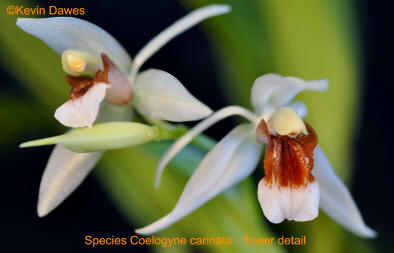The vast majority of Coelogyne carinata plants sold in Australia are mis-labeled as Coelogyne fragrans and from looking a photos on the web, this confusion seems to be world-wide. The main identifying factor is the colour of the column. Coelogyne carinata's column is basically entirely green while Coelogyne fragrans has orange to brown on the top (hood) of the column - often very bright.
It is normally associated with PNG, Irian Jaya and nearby islands such as the Solomons, as an epiphyte on rainforest trees down to coastal areas. It is generally found on small smooth barked trees along streams and rivers. Therefore, avoid frosts completely. Provide first class drainage, partial shade, water well and keep the humidity up.
Coelogyne carinata is a small to medium Coelogyne and its up to 8 (rarely) smallish flowers are quite attractively marked. It does have a very mild perfume. There is a lot of variation in the flower markings and there are suggestions that it may naturally hybridise with Coel fragrans (which adds even more to the identity confusion!).
It is easy to grow in intermediate to warm conditions with good humidity and may flower at any time of the year but generally prefers to bloom at the start of the 'wet' season. I find that the plant needs to become well established before it starts to flower well - i.e. the plant needs to be 5 or 6 years old.
Negatives: The flowers are relatively short-lived - about a week. It only flowers once a year. There are many Coelogynes that flower for a much longer period and would get my preference - especially if space is tight.
Rating: ♦♦♦
Sometimes sold as: Coel fragrans, Coel truncicola
Varieties: No known named varieties but it displays a lot of natural variation and is suspected of naturally hybridising in the wild, probably with Coelogyne fragrans.
Hybrids:
1. Coelogyne Kirribilli Norm - using Coelogyne speciosa as the pod parent (Kevin Dawes 2013).
Most hybridising efforts have focused on Coel fragrans but even so there are only 2 examples registered using Coelogyne fragrans.
| < Coel calcicola | Coel celebensis > |

